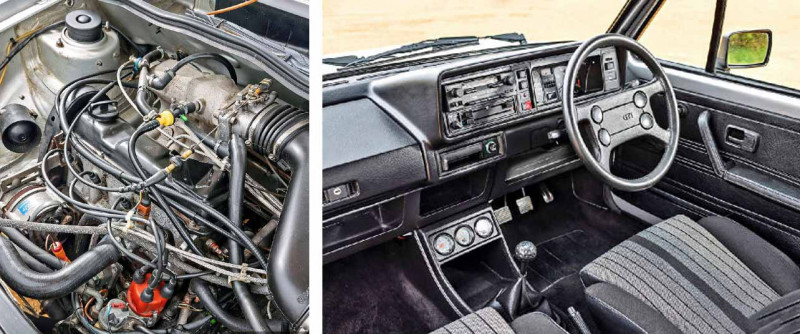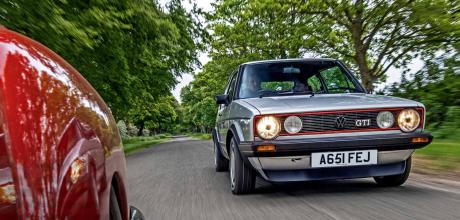1982 Volkswagen Golf GTI Mk1
After the distinctively cheeky character and idiosyncratic mechanicals of the rear-engined aircooled Volkwagens, getting into the firmly-bolstered plaid-clad drivers’ seat of this Golf GTI MkI feels like a total culture shock. Everything is angular, futuristic, hinting at computerised systems and digital precision, created in the same kind of ultra-rational post-oil-crisis idiom that produced things like the Porsche 928 and W126 Mercedes-Benz S-class. Only in-house stylist Herbert Schäfer’s contribution, the gearknob – Schäfer was a keen golfer – hints at any notion of fun. And yet in the Eighties, the Golf GTI would define driving excitement.
OK, so it isn’t the first hot hatch. That was probably the 1971 Autobianchi A112 Abarth. That said, both the Abarth and the GTI have a common ancestor. As aircooled sales began to flag in the early Seventies, VW’s NSU-based experiment with water-cooling and front-wheel drive, the K70, failed. Another part of VW’s Auto Union acquisition, Audi, bailed VW out with its 50 hatchback and 80 saloon, badge-engineered into the Polo and Passat for 1974. But the Golf was to replace the marque-defining Beetle, so had to be wholly VW in its conception. VW bought a Fiat 128 – the car upon which the A112 was based – and took it apart, using it as inspiration for the new Giugiaro-styled Golf.

Chief engineer Herbert Schuster spotted an opportunity to create a Sport Golf by installing the 80’s fuel-injected 1.6-litre engine, and persuaded VW development chief Ernst Fiala to green-light it so long as it was regarded as a 5000-example homologation special for Group 1 touring-car racing. In reality the MkI GTI’s racing career was an unspectacular affair led largely by privateers, but that didn’t matter – Schuster’s big idea was always for a different kind of practical performance car. One that united hatchback convenience and efficiency with Mini Cooper nippiness and sports-saloon thrust.
‘A different kind of performance car, one that united hatchback convenience with sports-saloon thrust’
Maybe this explains the Golf GTI’s sense of restraint. Rather than a new big idea to scream from the rooftops, it’s a tentative toe-dip in an uncertain new era, where Volkswagen knew failure meant the brand being relegated to developing-world licence-builds while Audi emphatically took its place.
It takes a long churn of the ignition and a few throttle pumps to prime the Bosch K-Jetronic mechanical injection, a reminder that it’s not quite as high-tech as it looks. Then there’s a potent boom from beyond the bulkhead as the engine fires.
From your position clamped into that firm seat, the GTI’s B-road handling and roadholding feels disarmingly direct. It seemingly boasts the grip of an Audi Quattro, but it comes minus the eventual understeer, darting so hard into corners it threatens to be painful after a while. After generations of easygoing Beetles, this feels revolutionary. Unsurprisingly, it wasn’t long before VW had sold far more than 5000 of them. Not all the expected hot hatch elements are present just yet though. It’s very long-geared, and the single-cam engine feels like the executive-saloon powerplant it is, refined and smooth yet needing its revs stretching to get into its power band past 2500rpm. The gearshift gate is a tad too notchy for quick-flick changes too. Short-shift and it’ll bog down.
But the real weak link is the Golf GTI’s brakes. They lack even a Beetle’s bite, and fade under hard use as the nose-heavy car bears down on them. Other manufacturers would perfect the hot hatch before VW struck back with better Golf GTIs, but in the context of the late Seventies and especially when delivering 114mph, 8.2-second 0-60 performance with faultless reliability, this car really was revolutionary.
Finding a 1.6-litre GTI is all but impossible in the UK. Righthand-drive production only began in 1979 and the 1.8-litre version – this is one – superseded it in 1982. MkI GTIs weren’t galvanised, so rust can run rampant through the inner structure – and they’re much more complex pressings than anything found in a Beetle. Bulkhead and A-pillar rust is a sign of an impending full restoration that could run to £20,000. Body panels are available from VW Heritage, and at, for example, £335 for a new front wing, they’re not overpriced.
This, plus increased interest in all things Eighties, means MkI GTIs fetch prices that make those restoration costs viable. If you want a mint one, you won’t get much change from £20k nowadays. However, their propensity to be modified means you can still find examples people have monkeyed about with for as little as £5k – hardly small change, but running one while gradually returning it to standard via eBay is a far more appealing prospect than attempting to resurrect a £2k rotbox.
Owning a MkI Golf GTI
‘My first car was a Golf MkI, a 1.1CL back in 1990, and I had a 1.5GX before getting my first GTI – Mars Red, seemingly like all the GTIs I’ve owned now,’ says Mark Dempsey, who currently owns a mint-condition 1.6. ‘I bought it three years ago, and it had received a lot of work,’ he says. ‘They rust badly, especially along the body seams towards the back of the car, so you’re best off buying one that has had this addressed. I paid £11k for this car three years ago and in terms of its condition it was a bargain. By contrast, 15 years ago I bought a rusty GTI for £1200 and it would’ve needed far more than £11k spending on it. ‘It’s been as reliable as my Porsche 911 Carrera 3.2. That said, it’s a 1.6 so certain parts are hard to come by. I needed a fuel injection module and ended up having to get a 1.8 unit modified instead.’
TECHNICAL DATA 1982 Volkswagen Golf GTI Mk1
- Engine 1781cc transverse four-cylinder, ohc, Bosch K-Jetronic fuel injection
- Max Power 112bhp @ 5800rpm
- Max Torque 109lb ft @ 3500rpm
- Transmission Five-speed manual, front-wheel drive
- Steering Rack and pinion
- Suspension Front: independent, MacPherson struts, telescopic dampers, anti-roll bar. Rear: independent, trailing arms, coil springs, telescopic dampers, anti-roll bar
- Brakes Discs front, drums rear, servo-assisted
- Performance Top speed: 114mph
- Acceleration 0-60mph: 8.2sec
- Weight 860kg
- Fuel consumption 37mpg
- Cost new £6177
- Classic Cars Price Guide £6000-£18,000
GTI powerplant came from Audi 80 exec saloon Cabin feels futuristic after aircooled cars.


